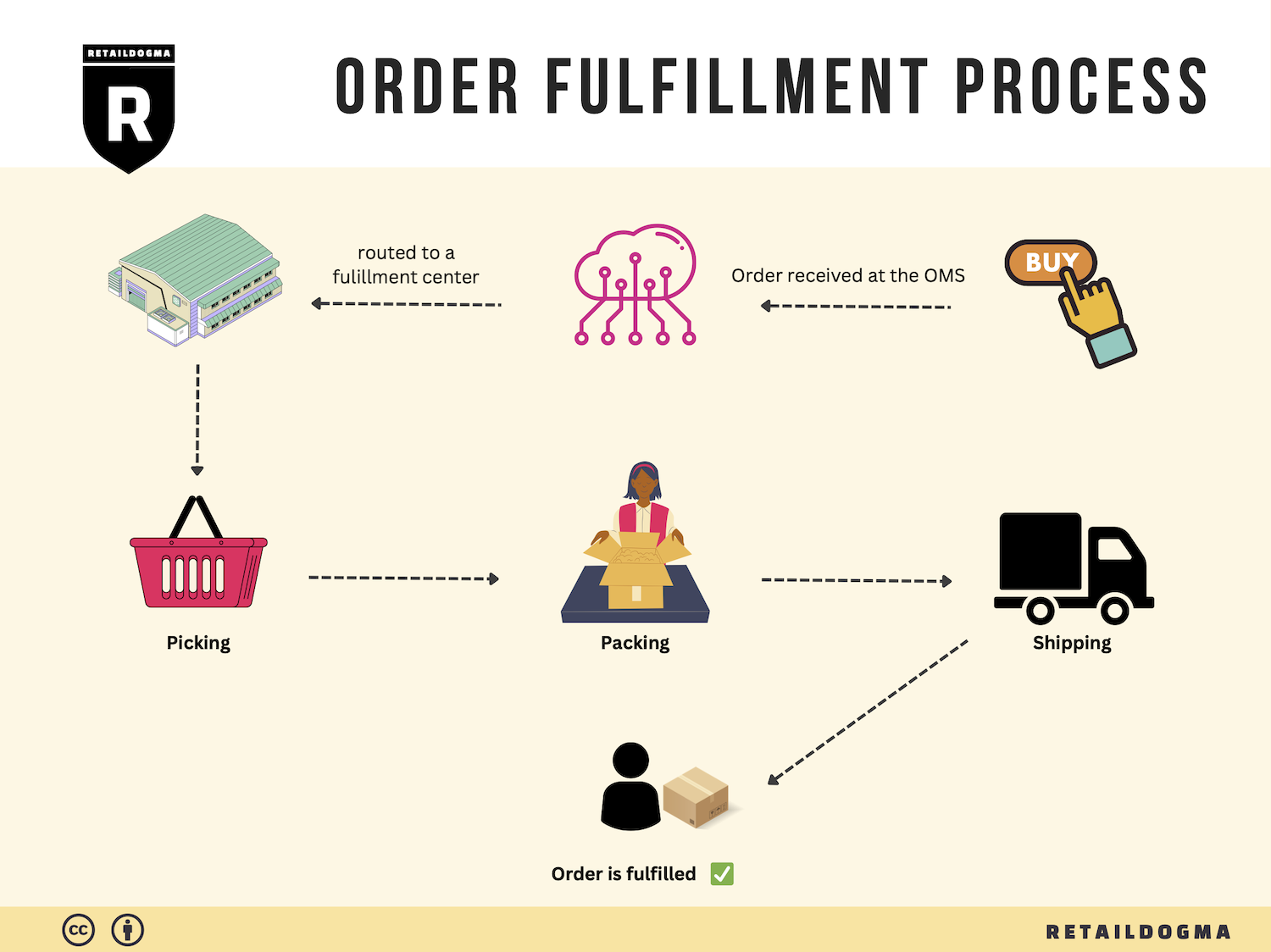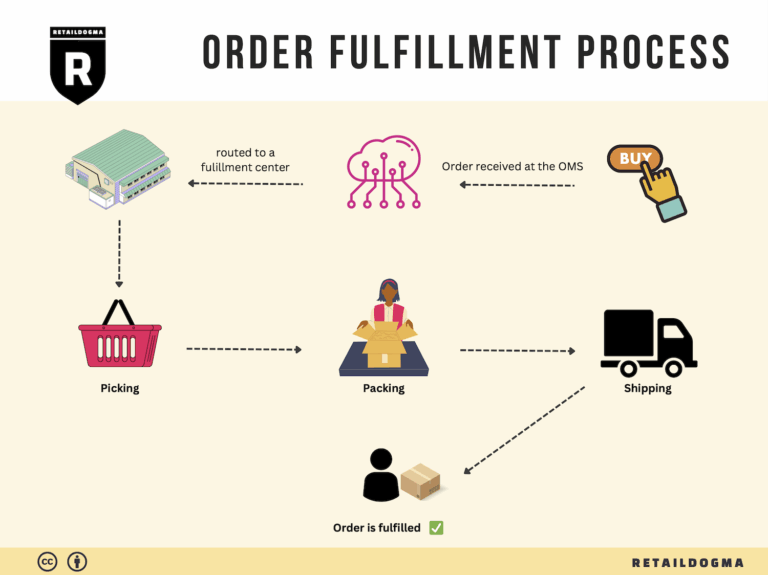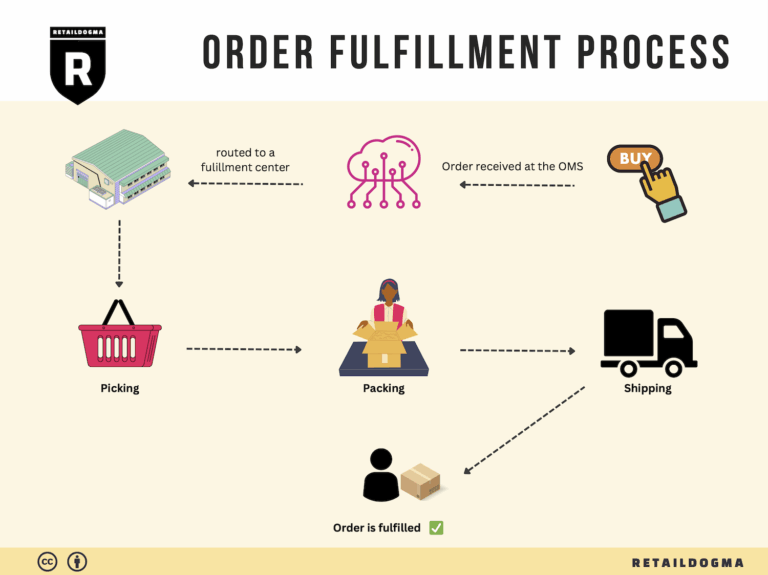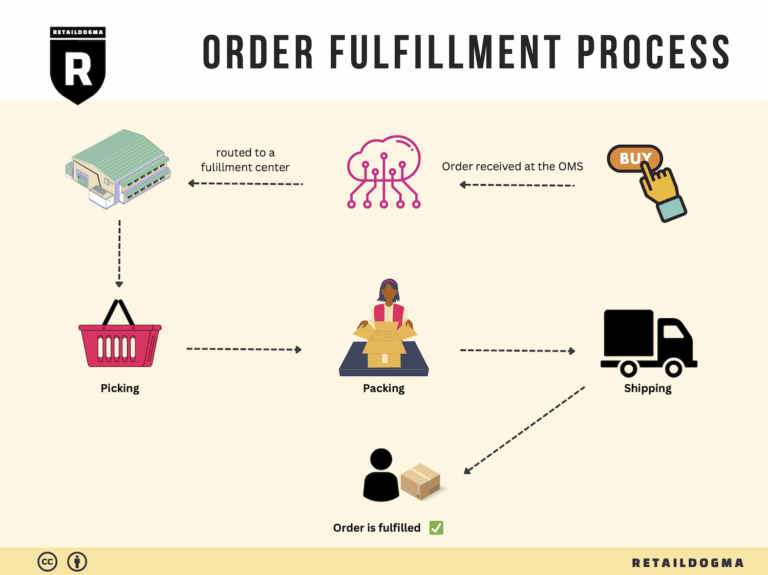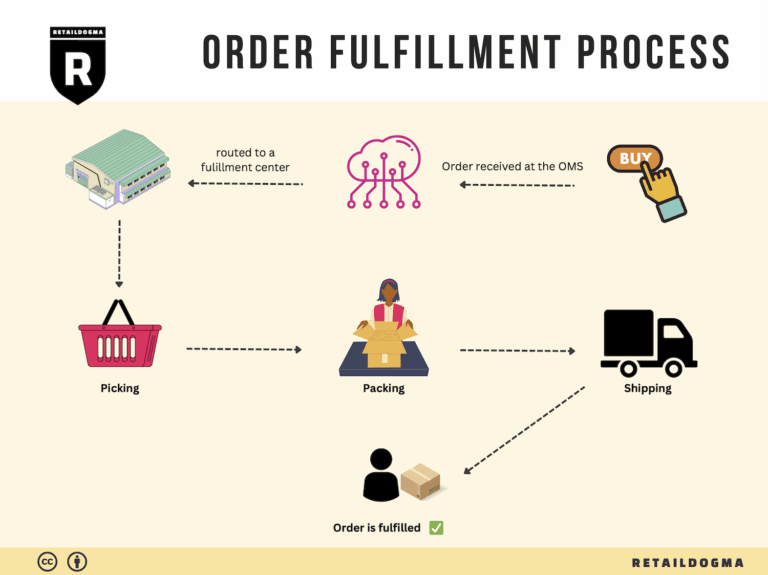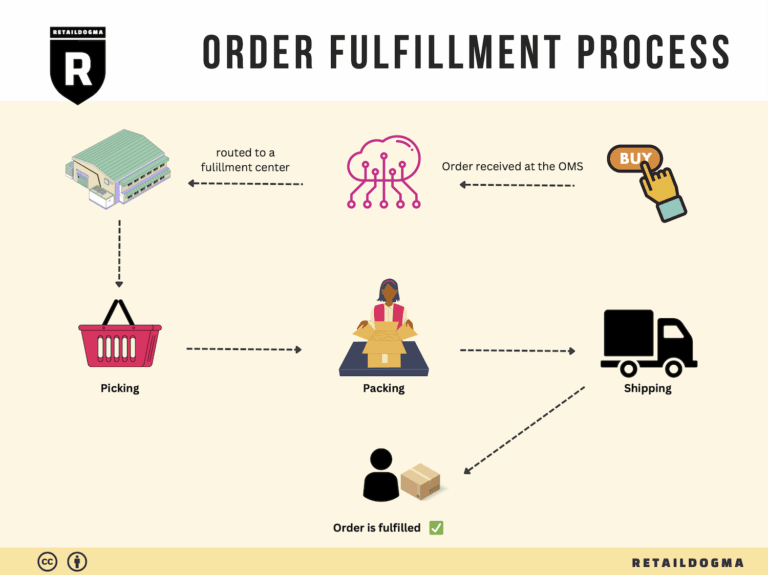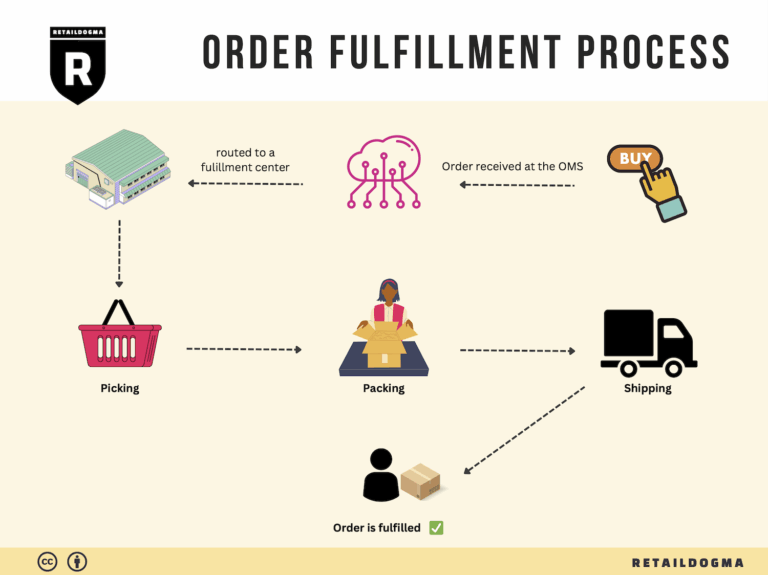Ecommerce Fulfillment Services: The Ultimate Guide (2025)
What is E-commerce Fulfillment? An Introduction for Growing Businesses
Understanding E-commerce Fulfillment: A Key to Scaling Your Business
For many growing online businesses, the logistics of packing and shipping orders can quickly become overwhelming. As sales increase, so does the complexity of ensuring that products reach customers in a timely and efficient manner. This is where e-commerce fulfillment steps in as a critical component of your operations. In its simplest form, fulfillment is the process of getting a product from your inventory to your customer’s doorstep.
Effective fulfillment not only impacts customer satisfaction but also influences your business’s ability to scale. As you navigate the challenges of order management, maintaining inventory levels, and optimizing shipping costs, understanding the various fulfillment models becomes essential. This guide will explore two primary fulfillment methods: Fulfillment by Amazon (FBA) and third-party logistics (3PL). Each has its strengths and weaknesses, and your choice will depend on your business goals, product type, and target market.
In addition to exploring fulfillment models, we will cover the core services that are integral to successful e-commerce fulfillment. These include inventory management, order processing, packing, shipping, and handling returns. Each service plays a vital role in ensuring a seamless experience for your customers and can significantly impact your bottom line.
Choosing the right fulfillment partner is another critical decision that can make or break your logistics strategy. We will provide insights on what to look for in a partner, including their technology capabilities, scalability, and customer service track record. Understanding pricing structures is equally important; we’ll break down the various cost components associated with fulfillment services, helping you to budget effectively as you scale.
The ultimate goal of this guide is to empower e-commerce business owners, operations managers, and entrepreneurs to make informed decisions about their logistics. By understanding the nuances of e-commerce fulfillment, you can enhance operational efficiency, improve customer satisfaction, and position your business for sustained growth in the competitive online marketplace.
What You’ll Learn In This Guide
- What is E-commerce Fulfillment? An Introduction for Growing Businesses
- The Order Fulfillment Process: From ‘Buy’ Button to Customer’s Door
- Comparing Fulfillment Models: In-House vs. 3PL vs. Dropshipping
- A Deep Dive into Amazon FBA: Pros, Cons, and Who It’s For
- Core Services Offered by Fulfillment Centers
- How to Choose a Fulfillment Partner: A 6-Point Checklist
- Understanding Fulfillment Pricing: A Breakdown of Common Fees
- Frequently Asked Questions (FAQs) about Fulfillment
- Conclusion: Is Outsourcing Fulfillment the Right Move for Your Business?
- Important Disclaimer
The Order Fulfillment Process: From ‘Buy’ Button to Customer’s Door
1. Receiving Inventory
The first step in the order fulfillment process begins when products arrive at the fulfillment center. This is known as the receiving phase, where inventory is carefully unloaded and checked for accuracy. Each item is scanned using a unique identifier, often referred to as a Stock Keeping Unit (SKU). This process not only verifies the quantity received but also ensures that the correct items have been delivered.
Importance: Effective receiving is crucial for maintaining accurate inventory levels and preventing stock discrepancies. If products are not properly logged into the system, it can lead to stock-outs or excess inventory, both of which can negatively impact sales and customer satisfaction.
Key Term: SKU (Stock Keeping Unit) – A unique identifier for each product that helps in tracking inventory throughout the fulfillment process.
2. Warehouse Storage
Once the inventory has been received and logged, it is then organized and stored in the fulfillment center. Advanced warehouse management systems (WMS) play a vital role in this step, utilizing algorithms to determine optimal storage locations based on factors such as product size, weight, and demand frequency. Items are often placed in designated zones to maximize space and facilitate quick access.
Importance: Proper warehouse storage is essential for efficient order fulfillment. It minimizes the time spent locating items, which is critical for meeting customer expectations for fast shipping. An organized storage system also helps in inventory management, reducing the risk of overstocking or stock-outs.
Key Term: WMS (Warehouse Management System) – A software application designed to support and optimize warehouse functionality and distribution center management.
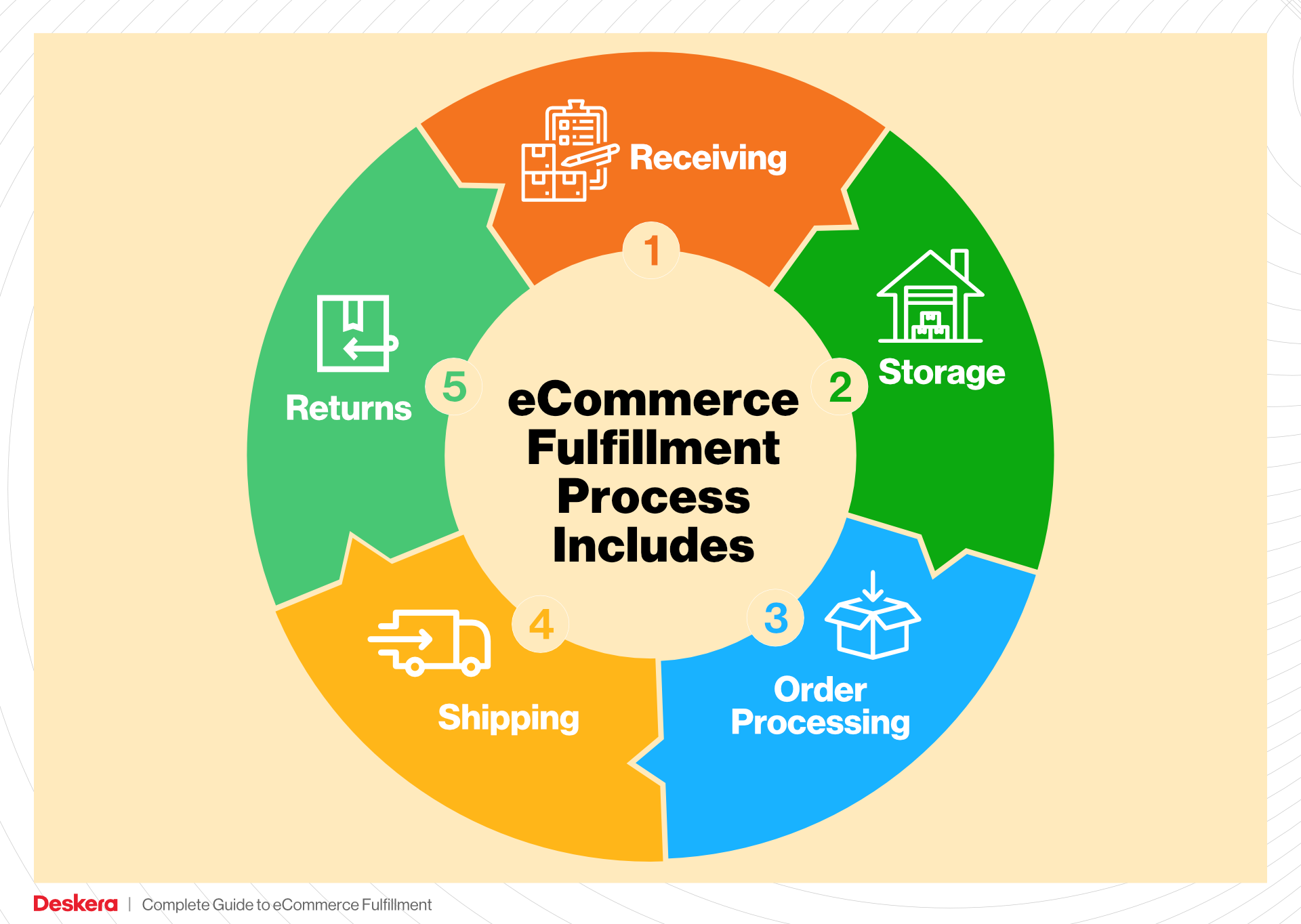
3. Order Picking
When a customer places an order, the fulfillment center initiates the picking process. This involves selecting the correct items from their storage locations. Workers or automated systems generate pick lists, which detail the items and their locations within the warehouse. Depending on the size of the order and the fulfillment center’s capabilities, picking can be done manually or through automated systems.
Importance: Efficient picking is vital for maintaining order accuracy and speed. Errors in this step can lead to incorrect shipments, which can frustrate customers and increase return rates. Fast and accurate picking also enables businesses to maintain a competitive edge in the e-commerce space.
Key Term: Pick List – A document or electronic list that outlines the items to be collected for fulfilling a customer order, including their locations within the warehouse.
4. Order Packing
After items are picked, they move to the packing stage. Here, products are carefully packed into boxes or other shipping containers, ensuring they are protected during transit. Packaging materials and methods are chosen based on the nature of the items being shipped, with considerations for weight, fragility, and size. Labeling is also done at this stage, which includes shipping addresses and tracking information.
Importance: Proper packing is crucial for minimizing damages during shipping and ensuring that customers receive their orders in excellent condition. It also plays a role in brand presentation; well-packaged items can enhance customer perception and satisfaction.
Key Term: Labeling – The process of affixing shipping information and tracking details to packages, which is essential for ensuring accurate delivery and tracking of shipments.
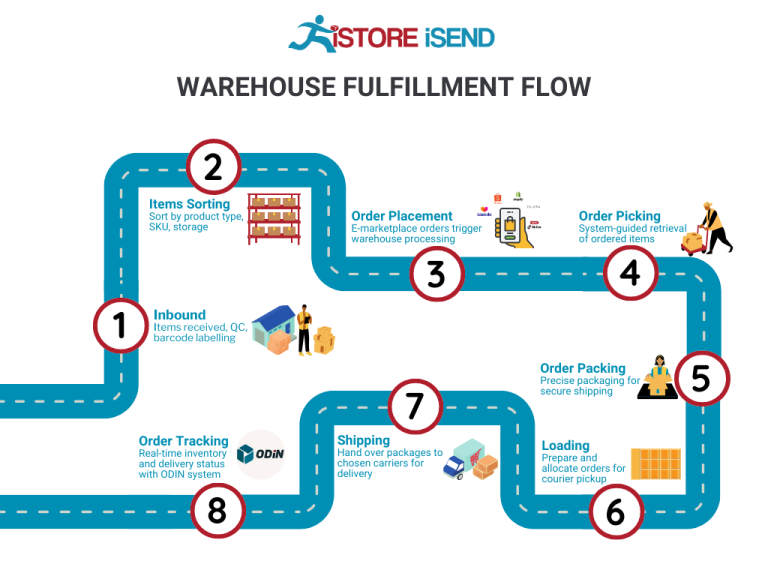
5. Shipping & Delivery
The final step in the order fulfillment process is shipping and delivery. Once packages are packed and labeled, they are handed over to shipping carriers for transport to the customer’s address. Fulfillment centers often have partnerships with multiple carriers to provide various shipping options, ensuring that they can meet diverse customer needs, including expedited shipping.
Importance: Timely and reliable shipping is one of the most significant factors influencing customer satisfaction in e-commerce. The fulfillment center’s ability to deliver orders quickly and accurately can directly impact a business’s reputation and customer loyalty.
Key Term: Final Mile Delivery – The last leg of the shipping process, where the package is delivered from a distribution center to the end customer, often considered the most critical part of the delivery experience.
By mastering each of these steps in the order fulfillment process, e-commerce businesses can streamline their operations, enhance customer satisfaction, and ultimately scale their sales and logistics effectively.
Comparing Fulfillment Models: In-House vs. 3PL vs. Dropshipping
Comparison of Fulfillment Models
| Model | Who Handles Inventory | Best For (Business Stage) | Key Advantage | Key Disadvantage |
|---|---|---|---|---|
| In-House Fulfillment | Business owner or internal team | Established businesses | Complete control over inventory and process | High operational costs and complexity |
| Third-Party Logistics (3PL) | 3PL provider | Growing businesses | Scalability and access to expertise | Less control over processes and inventory |
| Dropshipping | Supplier or manufacturer | Startups or small businesses | Low upfront investment and risk | Lower profit margins and quality control issues |
In-House Fulfillment
In-house fulfillment involves managing the entire logistics process within your own organization. This model is typically suited for established businesses that have the resources and infrastructure to handle inventory, order processing, and shipping. By maintaining control over all aspects of fulfillment, businesses can tailor their operations to meet specific customer needs, ensuring high-quality service and faster response times.
However, this model comes with significant challenges. The operational costs can be high, as businesses need to invest in warehousing, staffing, technology, and logistics management. Additionally, as order volumes grow, the complexity of managing fulfillment in-house can lead to inefficiencies and increased risk of errors. Businesses must also invest in robust inventory management systems to prevent stock-outs or overstock situations. For those ready to scale, in-house fulfillment can provide a competitive edge, but it requires careful planning and resource allocation.
Third-Party Logistics (3PL)
Third-party logistics (3PL) involves outsourcing fulfillment operations to specialized logistics providers. This model is particularly advantageous for growing businesses that seek to scale their operations without the burden of managing logistics in-house. 3PL providers offer a range of services, including warehousing, order processing, inventory management, and shipping. They typically have established networks and expertise that can help businesses optimize their supply chain.
One of the key advantages of using a 3PL is scalability. As your business grows, a 3PL can quickly adapt to increased demand, providing additional resources and capabilities as needed. They often have access to advanced technology and logistics solutions that can enhance efficiency and reduce costs. However, the downside is that businesses may have less control over their inventory and fulfillment processes. Communication and coordination with the 3PL are crucial to ensure that service levels meet customer expectations. For businesses looking to expand rapidly while minimizing logistical headaches, partnering with a 3PL can be a strategic move.
Dropshipping
Dropshipping is a fulfillment model where the retailer does not hold inventory but instead relies on suppliers to fulfill customer orders directly. This model is ideal for startups or small businesses with limited capital, as it eliminates the need for upfront investment in inventory and warehousing. Retailers can offer a wide range of products without the risks associated with unsold stock, making it a flexible option for those testing new markets or product lines.
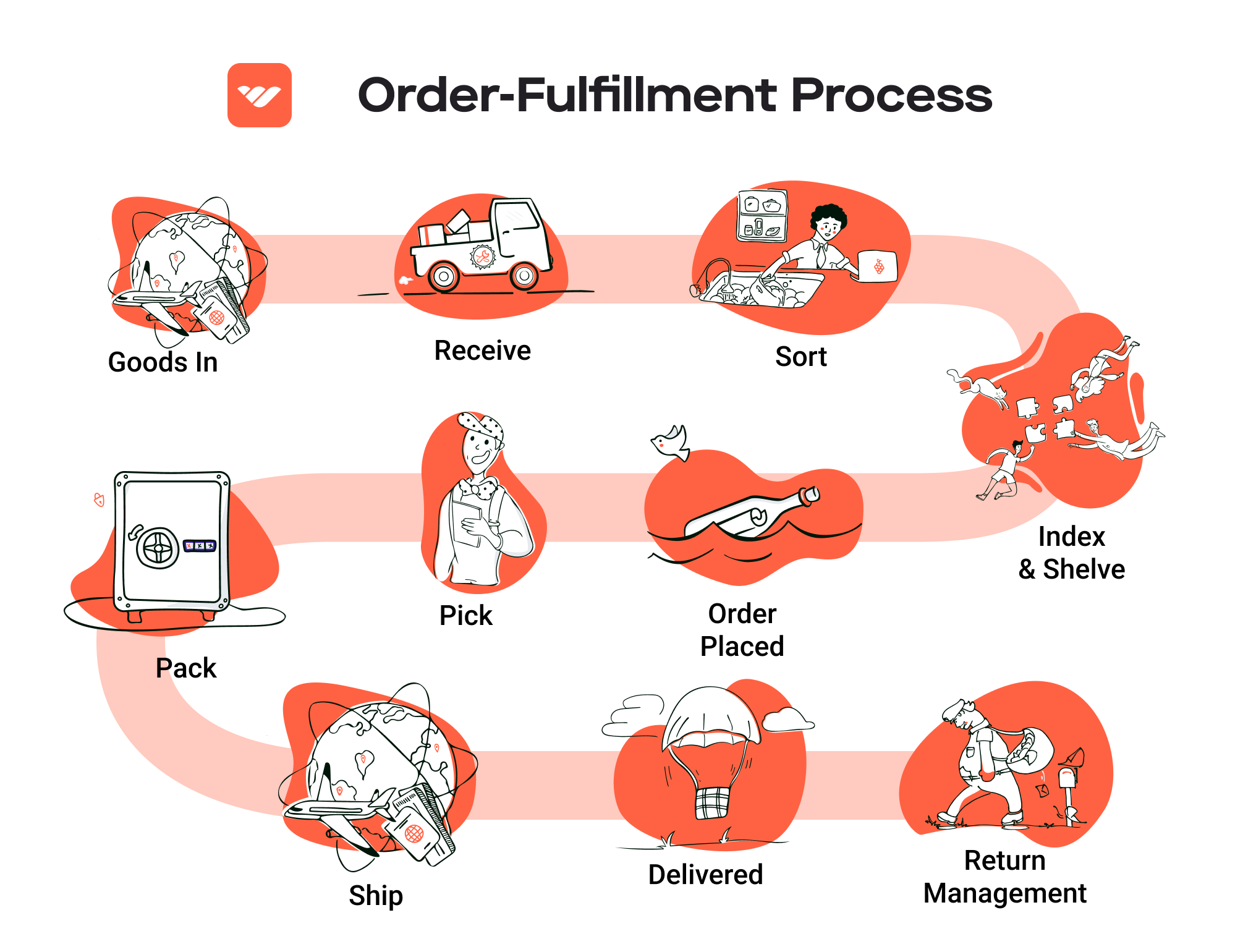
While dropshipping offers low operational costs and reduced risk, it also presents challenges. Profit margins can be lower compared to other fulfillment models, as retailers often pay a premium for the convenience of not managing inventory. Furthermore, quality control can become an issue, as retailers rely on suppliers to deliver products that meet customer expectations. Shipping times may also be longer, especially if suppliers are located overseas. To succeed in dropshipping, businesses must carefully select reliable suppliers and establish clear communication channels to ensure that customer service remains a priority. For entrepreneurs seeking to minimize risk and test their business ideas, dropshipping can be an effective starting point.
Conclusion
Choosing the right fulfillment model is a critical decision for e-commerce businesses looking to scale. Each model—whether in-house fulfillment, third-party logistics, or dropshipping—offers unique advantages and disadvantages that must be carefully weighed against business goals, resources, and market demands. Understanding the nuances of these models will empower business owners and operations managers to make informed decisions that align with their growth strategies.
A Deep Dive into Amazon FBA: Pros, Cons, and Who It’s For
Understanding Fulfillment by Amazon (FBA)
Fulfillment by Amazon (FBA) is a service offered by Amazon that allows e-commerce sellers to leverage Amazon’s vast logistics network to store, pick, pack, and ship their products. When businesses enroll in FBA, they send their products to Amazon’s fulfillment centers, where Amazon takes care of the rest—from inventory management to customer service. This service is particularly beneficial for sellers looking to scale their operations, as it enables them to focus on product development and marketing rather than logistics.
How FBA Works
-
Inventory Shipment: Sellers ship their products to one or more of Amazon’s fulfillment centers. They can create shipment plans through their Amazon Seller Central account, which provides guidelines on how to prepare and package products for shipment.
-
Storage: Once the products arrive at the fulfillment centers, they are scanned into Amazon’s inventory management system and stored until an order is placed.
-
Order Processing: When a customer places an order for a product listed as FBA, the fulfillment center nearest to the customer retrieves the item, picks it from the shelves, and prepares it for shipment.
-
Packing and Shipping: Amazon handles the packing of the product and manages the shipping process. They utilize their logistics network to ensure that packages are delivered to customers quickly, often within one or two days.
-
Customer Service and Returns: FBA also includes customer service support. Amazon manages inquiries and handles returns, making the process seamless for both sellers and buyers.
Pros of Fulfillment by Amazon (FBA)
-
Prime Eligibility: One of the most significant advantages of using FBA is that products become eligible for Amazon Prime. This enhances visibility and attractiveness to millions of Prime members who are more likely to purchase items that qualify for free two-day shipping.
-
Customer Trust: By using FBA, sellers benefit from the trust and credibility associated with the Amazon brand. Customers are often more inclined to purchase products fulfilled by Amazon, knowing they will receive reliable service, quick shipping, and easy returns.
-
Multi-Channel Fulfillment: FBA allows sellers to fulfill orders from their own websites and other sales channels through Amazon’s logistics network. This means that businesses can streamline their operations and use Amazon’s infrastructure for all their order fulfillment needs, not just Amazon.com.
-
Scalability: FBA provides the ability to scale operations without the need for significant investment in logistics infrastructure. As demand grows, sellers can easily increase inventory levels and rely on Amazon’s capabilities to handle larger volumes.
-
Reduced Operational Burden: By outsourcing fulfillment to Amazon, sellers can free up time and resources to focus on other aspects of their business, such as product development and marketing.
Cons of Fulfillment by Amazon (FBA)
-
High Fees: FBA can be costly, especially for small businesses. Sellers incur various fees, including storage fees for inventory stored in Amazon warehouses and fulfillment fees for each unit sold. These costs can eat into profit margins, particularly for lower-priced items.
-
Strict Inventory Rules: Amazon has specific requirements for product preparation and packaging. Sellers must adhere to these rules to avoid penalties or inventory removal. Failure to comply can result in additional fees or inventory being returned or disposed of.
-
Commingling Risks: FBA products from different sellers can be commingled in Amazon’s warehouses. This means that when a seller’s product is ordered, it may be shipped from another seller’s inventory. This can lead to issues with product quality and authenticity, potentially harming the seller’s brand reputation.
-
Limited Control Over Customer Experience: While Amazon manages customer service, sellers have limited control over how their products are presented and how customer interactions are handled. This can lead to challenges if customer service issues arise or if there are discrepancies in branding.
-
Inventory Management Challenges: Sellers must be vigilant about managing inventory levels to avoid stockouts or overstocking, which can lead to increased fees. Additionally, sellers must consider lead times for restocking inventory to ensure that they can meet customer demand.
Who is FBA Best For?
Fulfillment by Amazon is particularly well-suited for:
-
Small to Medium-Sized Businesses: Companies looking to grow quickly without investing heavily in logistics can benefit from the scalability and efficiency of FBA.
-
Sellers with High Volume: Businesses that sell products with a high turnover rate or high sales volume may find that the convenience of FBA offsets its costs.
-
E-commerce Entrepreneurs: Startups and entrepreneurs who want to leverage Amazon’s massive customer base and logistics infrastructure can find FBA to be a valuable resource for gaining traction in the market.
-
Brand Owners: Companies that have established a strong brand presence but need help managing logistics can use FBA to enhance their customer service and delivery capabilities while focusing on brand growth.
In conclusion, Fulfillment by Amazon can be a powerful tool for e-commerce businesses looking to streamline their operations and scale efficiently. However, it’s crucial for sellers to weigh the pros and cons carefully and consider their specific business needs before deciding to enroll in FBA.
Core Services Offered by Fulfillment Centers
Inventory Management & Warehousing
Inventory management is a critical component of any e-commerce operation. Fulfillment centers offer sophisticated inventory management systems that help businesses keep track of their stock levels, monitor product turnover rates, and maintain optimal stock levels. These systems utilize advanced technology such as barcode scanning and real-time data analytics to ensure that inventory is accurately recorded and easily accessible.
The benefits of effective inventory management through fulfillment centers are manifold. First, it minimizes the risk of stockouts, which can lead to lost sales and dissatisfied customers. By having a clear view of inventory levels, businesses can better forecast demand and make informed purchasing decisions. Additionally, fulfillment centers typically provide secure warehousing solutions that protect products from damage or theft while also facilitating efficient space utilization. This allows e-commerce businesses to scale their operations without the overhead costs associated with maintaining their own warehousing facilities.
Pick and Pack Services
Pick and pack services are essential for e-commerce businesses that require efficient order fulfillment. This process involves selecting the right products from inventory (picking) and then packaging them appropriately for shipment (packing). Fulfillment centers employ trained staff and advanced automation technology to streamline this process, significantly reducing the time it takes to fulfill orders.
The primary benefit of pick and pack services is the speed and accuracy they provide. In today’s fast-paced e-commerce environment, consumers expect rapid delivery times. Fulfillment centers can often process orders more quickly than an in-house team could, especially during peak seasons. Additionally, accuracy in picking ensures that customers receive the correct items, thereby reducing return rates and enhancing customer satisfaction. With fulfillment centers handling these tasks, businesses can focus on core activities such as marketing and product development, ultimately driving growth.
Kitting and Assembly
Kitting and assembly services involve combining multiple products into a single package or kit. This can include assembling items that need to be put together before shipping, such as furniture or electronics, or bundling complementary products, such as a shampoo and conditioner set. Fulfillment centers can manage this process efficiently, ensuring that products are correctly packaged and ready for delivery.
The benefits of kitting and assembly services are significant for e-commerce businesses. First, they can lead to cost savings in shipping by consolidating items into a single package, reducing shipping fees. Additionally, kitting can enhance the customer experience by providing a curated selection of products that encourage upselling. This service also allows businesses to streamline their inventory management by reducing the number of individual SKUs they need to track. Overall, kitting and assembly can improve operational efficiency and customer satisfaction.
Returns Management (Reverse Logistics)
Returns management, often referred to as reverse logistics, is the process of handling returned goods. Fulfillment centers provide essential services for managing returns, including inspecting returned items, restocking them when appropriate, and processing refunds or exchanges. This service is particularly important in e-commerce, where return rates can be high due to factors such as incorrect sizing or buyer’s remorse.
The benefit of an efficient returns management system is that it helps maintain customer loyalty. Customers are more likely to shop again with a brand that makes the return process simple and hassle-free. Fulfillment centers can streamline this process by quickly processing returns and ensuring that restocked items are available for resale. Additionally, managing returns effectively can provide valuable data on product performance and customer preferences, enabling businesses to make informed decisions about their inventory and marketing strategies. By outsourcing returns management to fulfillment centers, businesses can focus on growth while ensuring a positive customer experience.
In summary, fulfillment centers offer a range of core services that are indispensable for e-commerce businesses looking to scale. By leveraging these services, businesses can improve operational efficiency, enhance customer satisfaction, and ultimately drive sales growth.
How to Choose a Fulfillment Partner: A 6-Point Checklist
Location & Warehouse Network
Importance: The geographical location of your fulfillment partner’s warehouses can significantly impact shipping times, costs, and customer satisfaction. A strategically located partner can help ensure faster delivery to your target market.
Questions to Ask:
– Where are your fulfillment centers located, and how do those locations align with my customer base?
– How do you manage shipping logistics to ensure timely deliveries?
– Do you have facilities in multiple regions to facilitate quicker shipping and lower costs?
Technology & Integrations
Importance: Advanced technology and seamless integrations with your e-commerce platform are essential for efficient order processing and inventory management. A partner that uses modern warehouse management systems (WMS) can help streamline your operations and reduce errors.
Questions to Ask:
– What technology do you use for order processing and inventory management?
– Can your systems integrate with my existing e-commerce platforms (like Shopify, WooCommerce, etc.)?
– Do you offer real-time tracking and reporting features for inventory and orders?
Specializations (e.g., Cold Storage, Oversized Items)
Importance: Depending on your product range, you may need a fulfillment partner that specializes in handling specific types of items, such as perishables, hazardous materials, or oversized goods. This ensures that your products are stored and handled correctly.
Questions to Ask:
– Do you have experience handling my specific product types?
– What special facilities or equipment do you have to manage these items (e.g., refrigeration for cold storage)?
– Can you provide examples of how you have successfully managed similar products for other clients?
Scalability & Capacity
Importance: As your business grows, your fulfillment needs will evolve. A partner that can scale with your business will save you from the hassle of switching providers as your order volume increases.
Questions to Ask:
– What is your current capacity, and how do you handle seasonal spikes in demand?
– Can you accommodate sudden increases in order volume without compromising service quality?
– How do you ensure that your facilities and staffing can scale alongside my business growth?
Pricing and Contracts
Importance: Understanding the pricing structure and contract terms is critical for budgeting and financial planning. A transparent pricing model helps you avoid unexpected costs and ensures that you can maintain profitability.
Questions to Ask:
– What is your pricing model (e.g., per order, per item, monthly fees)?
– Are there any hidden fees (e.g., storage fees, pick and pack fees, returns handling)?
– What are the terms of your contracts, and what options do I have for scaling up or down?
Customer Support & Reviews
Importance: Reliable customer support is crucial for addressing any issues that may arise during fulfillment. Partnering with a provider that has a good reputation for customer service can enhance your overall business operations.
Questions to Ask:
– What kind of customer support do you offer (e.g., phone, email, chat)?
– How quickly can I expect responses to my inquiries or issues?
– Can you provide references or case studies from other clients, particularly those in my industry?
Conclusion
Choosing the right fulfillment partner is a vital step in scaling your e-commerce business. By using this checklist, you can systematically evaluate potential partners based on their location, technology, specializations, scalability, pricing, and customer support. A thorough assessment will help ensure that you select a partner who aligns with your business goals and can support your growth effectively. Taking the time to ask the right questions will not only save you time and money but will also enhance your overall customer satisfaction.
Understanding Fulfillment Pricing: A Breakdown of Common Fees
Initial Setup Fees
When partnering with a fulfillment center, the initial setup fee is often the first cost incurred. This fee can vary widely depending on the provider and services offered. Typically, it encompasses the costs associated with onboarding your products into the system, which may include inventory entry, account setup, and configuration of your storage and fulfillment parameters.
The calculation of initial setup fees can be based on several factors:
– Complexity of Inventory: If your products require special handling or additional information, such as barcoding or custom labeling, this may increase your setup costs.
– Technology Integration: If the fulfillment center needs to integrate with your existing e-commerce platform, this may involve additional costs.
– Volume of Products: Larger inventories may incur higher fees due to the increased time and labor involved in setup.
Receiving Fees
Receiving fees are charges that apply when your products arrive at the fulfillment center. These fees cover the labor and resources required to unload, inspect, and log your inventory into the system.
Receiving fees are generally calculated based on:
– Quantity of Items: Most fulfillment centers charge a per-item fee for receiving, which can vary depending on the nature of the items (e.g., bulky items might incur higher fees).
– Inspection Requirements: If your products require a quality check or specific handling upon arrival, this can also impact the receiving fee.
Storage Fees (per pallet/bin)
Storage fees are incurred for the space your inventory occupies within the fulfillment center. These fees are typically charged monthly and can vary based on the size of the items stored.
The calculation of storage fees generally considers:
– Volume of Inventory: Fees are often charged per pallet or bin, meaning that the more space your products take up, the higher the storage costs.
– Duration of Storage: Some fulfillment centers may offer tiered pricing based on how long your inventory remains in storage. Longer durations can lead to increased fees, especially if your inventory exceeds a predetermined threshold.
Pick & Pack Fees (per item/order)
Pick and pack fees are charged for the actual process of retrieving items from storage and preparing them for shipment. This fee is crucial for e-commerce businesses, as it directly impacts the fulfillment cost per order.
These fees are typically calculated based on:
– Number of Items per Order: Most fulfillment centers charge a base fee for picking an order, plus an additional fee for each item included in that order.
– Complexity of Packing: If items require special packaging or kitting (combining multiple products into one package), this may incur extra fees.
Shipping Fees
Shipping fees are one of the most significant costs associated with fulfillment and can vary depending on several factors, including shipping speed, destination, and carrier choice.
The calculation of shipping fees usually involves:
– Weight and Dimensions of Packages: Carriers often charge based on the weight and size of the package, so heavier or larger items will typically incur higher fees.
– Shipping Speed: Different service levels (e.g., standard, expedited, overnight) come with varying costs. Fulfillment centers may offer options that impact your overall shipping expenses.
– Destination: Shipping costs can differ significantly based on whether the package is being sent locally, nationally, or internationally.
Conclusion and Tips for Accurate Quotes
Understanding the various fulfillment pricing models is essential for budgeting and scaling your e-commerce operations. To obtain an accurate quote from a fulfillment center, consider the following tips:
- Be Transparent About Your Needs: Provide detailed information about your inventory, including dimensions, weight, and any special handling requirements.
- Request a Detailed Breakdown: Ask for a comprehensive breakdown of all fees associated with your order fulfillment, including setup, receiving, storage, pick & pack, and shipping.
- Compare Multiple Providers: Don’t settle for the first quote you receive. Comparing several fulfillment centers can help you find the best value for your specific needs.
- Inquire About Volume Discounts: If you anticipate significant order volumes, ask about discounts that may apply as your business scales.
- Consider Additional Services: Determine if you need additional services such as returns handling or custom packaging, as these can also affect your overall costs.
By thoroughly understanding these components, you can better manage your fulfillment costs and enhance your e-commerce operations.
Frequently Asked Questions (FAQs) about Fulfillment
1. What is an Amazon Fulfillment Center?
An Amazon Fulfillment Center is a large warehouse where Amazon stores products, processes orders, and ships items directly to customers. These centers are strategically located to optimize shipping times, ensuring quick delivery for millions of items. They utilize advanced technology and automation to handle the logistics efficiently, allowing for rapid order fulfillment.
2. How does Fulfillment by Amazon (FBA) work?
Fulfillment by Amazon (FBA) allows sellers to store their products in Amazon’s fulfillment centers. When a customer places an order, Amazon handles the picking, packing, shipping, and customer service on behalf of the seller. This service enables sellers to leverage Amazon’s logistics network, ensuring fast and reliable delivery, often with Prime shipping options.
3. What is the difference between a warehouse and a fulfillment center?
While both warehouses and fulfillment centers store goods, their purposes differ significantly. A warehouse primarily focuses on storing inventory for long-term use, while a fulfillment center is designed for the efficient processing and shipping of orders. Fulfillment centers have advanced systems for order management, packing, and shipping, enabling quicker turnaround times.
4. What is a Third-Party Logistics Provider (3PL)?
A Third-Party Logistics Provider (3PL) is a company that offers outsourced logistics services, which can include warehousing, order fulfillment, shipping, and inventory management. Many e-commerce businesses partner with 3PLs to streamline their operations, allowing them to focus on core business activities while leveraging the expertise and infrastructure of the 3PL.
5. How much do fulfillment services cost?
The cost of fulfillment services can vary widely based on factors such as the size and weight of the products, order volume, and specific services required (e.g., kitting, labeling). Generally, costs may include storage fees, picking and packing fees, shipping charges, and any additional service fees. It’s essential for businesses to evaluate their needs and request quotes from fulfillment service providers to understand the total cost.
6. What are the benefits of using Fulfillment by Amazon (FBA)?
Using FBA offers numerous advantages, including access to Amazon’s vast customer base, eligibility for Prime shipping, and reduced shipping costs. FBA also simplifies logistics for sellers, as Amazon manages storage, order processing, and customer service, allowing sellers to focus on growing their business.
7. Can I use both FBA and Fulfillment by Merchant (FBM)?
Yes, sellers can use both Fulfillment by Amazon (FBA) and Fulfillment by Merchant (FBM) simultaneously. This hybrid approach allows sellers to choose which products to fulfill via Amazon and which to manage independently, providing flexibility in logistics strategies based on inventory levels and customer demand.
8. What happens if a product is damaged during shipping?
If a product is damaged during shipping, the seller can initiate a return or claim process through Amazon or their fulfillment provider. Amazon typically has policies in place to manage damaged goods, including inspections and potential reimbursements, depending on the circumstances surrounding the damage.
9. How does inventory management work in fulfillment centers?
Inventory management in fulfillment centers involves tracking the flow of goods from receipt to storage and eventually to shipping. Advanced software systems are used to monitor stock levels, manage reordering processes, and optimize storage space. This ensures that products are readily available for quick order fulfillment while minimizing the risk of stock-outs or overstock situations.
10. How can I ensure timely order fulfillment?
To ensure timely order fulfillment, businesses should regularly monitor inventory levels, use reliable fulfillment services, and maintain clear communication with logistics partners. Implementing efficient order processing systems and utilizing real-time tracking can also help streamline operations and improve overall customer satisfaction.
Conclusion: Is Outsourcing Fulfillment the Right Move for Your Business?
Assessing the Benefits of Outsourcing Fulfillment
Outsourcing fulfillment can be a transformative strategy for e-commerce businesses looking to scale efficiently. By leveraging fulfillment services, businesses can save significant time and resources. These services handle everything from inventory management to shipping, allowing you to focus on core operations such as product development and marketing. This shift not only streamlines your workflow but also enhances your ability to respond to market demands swiftly.
Scalability is another compelling advantage. As your business grows, so do the complexities of order fulfillment. A reliable fulfillment partner provides the infrastructure and expertise necessary to manage increased order volumes without compromising service quality. This flexibility allows you to expand into new markets or product lines with confidence, knowing that your logistics are in capable hands.
Expertise is paramount in today’s fast-paced e-commerce environment. Partnering with a specialized fulfillment service means you gain access to industry knowledge and best practices that can significantly improve your operational efficiency. From advanced technology for inventory tracking to optimized shipping routes, these partners equip your business with tools that can enhance customer satisfaction and retention.
Choosing the Right Partner for Growth
Selecting the right fulfillment partner is crucial for sustained growth. It’s essential to evaluate potential partners based on their capabilities, technology, and customer service. A thorough audit of your current shipping processes can reveal areas where you might benefit from outsourcing. Consider factors such as order volume, delivery speed, and customer expectations in your assessment.
Call to Action
Take the next step in your growth journey by auditing your current fulfillment strategy. Ask yourself: Are you maximizing efficiency and customer satisfaction? If not, it may be time to explore outsourcing your fulfillment to a partner that aligns with your business goals. Embrace the opportunity to scale with confidence, leveraging the expertise and resources that a fulfillment service can provide.
Important Disclaimer
⚠️ Important Disclaimer
The information in this guide is for educational purposes. Fulfillment services, pricing, and platform features change frequently. Always conduct your own due diligence and consult with providers directly before making business decisions.
